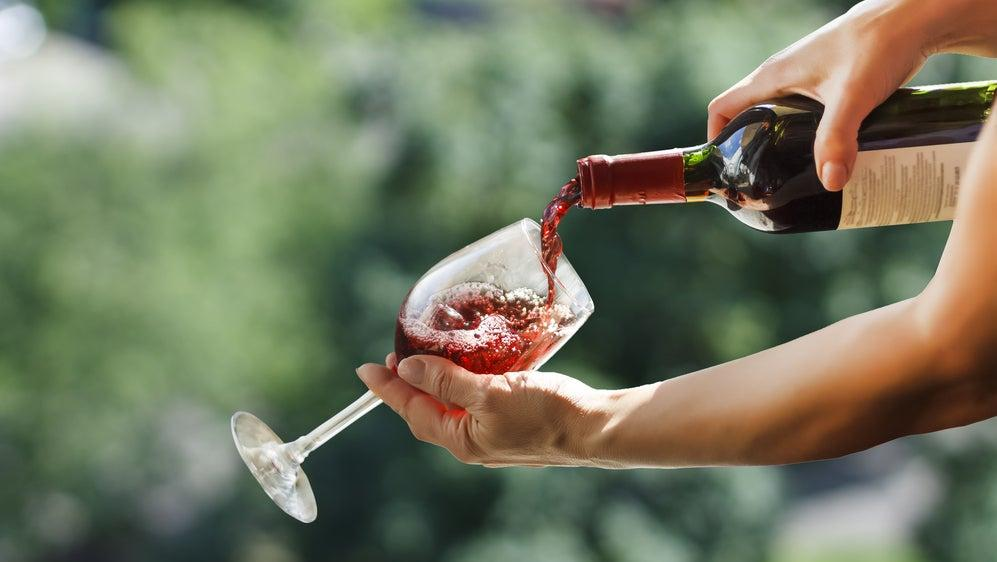The Truth Behind 3 Common Wine Myths
An expert explains why we age, chill, and pour wine the way we do.
If you're a wine novice like me, then you probably have some preconceived notions about the drink that may or may not be based in fact. I've picked up a lot of wine knowledge secondhand by observing other people enjoying it, without ever questioning certain truths or practices.
Why, for example, do people hold onto red wines for years in order to improve the taste? Why must I enjoy a red at room temperature while white wine must be chilled? And why is it such a faux pas to fill up my wine glass all the way? These are the questions I demand answers to.
Thankfully, Jim Bube, a master sommelier and the current National Wine Director for Hogsalt restaurant group, has lent me his expertise once again so we can all gain a better understanding of proper wine etiquette.
Should you age red wine before drinking it?
There's actually no real need to age your red wine. Bube explains that most wines are released or sold ready to enjoy. So, if you purchased a bottle of wine and wanted to save it for a special occasion, you can—but if you're simply unable to wait, there's no need to panic. Cracking that bad boy open ahead of schedule will not mean a less-than-optimal taste.
"It sort of depends on how ripe you like your banana," explains Bube. "Most wine is released somewhat ripe and ready to go... the majority of wine that is sold in the United States is probably best enjoyed young, and this includes some of the more expensive wines that are out there."
This isn't to say that aging or waiting to enjoy a bottle won't have any effect on the experience. Aging a bottle of red will change the way it tastes. "All of those fresh, fruity flavors sort of dry out and fall into the background, ” says Bube. "Oftentimes the savory elements will increase while the fruity elements decrease." Bube also notes that the tannins (the molecules that give red wine its dry quality) will soften in an aged bottle, and generally the wine becomes a bit less astringent.
However, overall, the decision to age a red wine (or even a white) comes down to personal preference, as the process isn't always reliable.
Why chill white wine, but never red?
My mom always tells me to put white wine in the refrigerator but never the red, and I've always accepted this as the proper way to serve each type of wine. It turns out that Bube has proven my mom wrong. The serving temperature of a wine is, like the aging process, more determined by personal preference than anything else.
"I think nine times out of 10, white wine is served too cold at restaurants, and red wine is served too warm," says Bube, who actually prefers both whites and reds to be slightly chilled. He believes lowering the serving temperature of either wine improves their drinkability by giving them a more refreshing element while maintaining their overall character and integrity.
I wholeheartedly agree with Bube on this one, and I'm glad to know that I can throw my bottles of red wine into the refrigerator for a little while without any concern that I might be hindering my drinking experience. As for white wine, if you need to chill a bottle quickly, Bube says you can wrap it in a wet towel (or wet paper towels) and pop it in the freezer for several minutes.
Why don’t we fill wine glasses to the top?
Pouring wine so that the glass is only about 30% full is another practice I've observed and been told (by my mother) is absolutely necessary. Well, Mom, you were right about this one.
The reason for this, explains Bube, is that you want to be able to smell the wine as much as possible. "What helps you do this is a little bit more space for that wine to stretch out aromatically," he says. "Think about the design and shape of a wine glass: generally it's going to be a little wider to the middle, which is where it's designed to be filled to." This means if you fill the glass to the top, there will be less surface area for you to smell and take in the qualities of the wine.
(Fun tip: To truly put this practice to the test, Bube suggests tasting the same wine in different sizes and shapes of glasses and at different pour levels.)
Similarly, there's a reason people swirl their wine around inside the glass, and it's not just to look fancy. Doing so creates more areas where the wine is clinging to the sides of the glass, bringing those aromatics closer to your nose for smelling.
Yet again, Bube has changed what I thought I knew about wine and helped to quench my recurring thirst for wine knowledge. Until our next lesson, I hope you enjoy your freshly purchased, lightly chilled wine in a glass designed for optimal sniffing.
